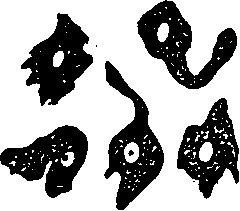Haemoglobin
Description
This section is from the book "The Human Body: An Elementary Text-Book Of Anatomy, Physiology, And Hygiene", by H. Newell Martin. Also available from Amazon: The Human Body.
Haemoglobin
Each red corpuscle is soft and jelly like. Its chief constituent, besides water, is a substance called haem'-o-glo'-bin, which has the power of combining with oxygen when in a place where that gas is plentiful, and of giving it off again in a region where oxygen is absent or present only in small quantity. Hence as the blood flows through the lungs, which are constantly supplied with fresh air, its corpuscles take up oxygen, which, as it flows on, is carried by them to distant parts of the body where oxygen is deficient, and there given up to the tissues. This oxygen-carrying is the function of the red corpuscles.
Arterial And Venous Blood
Hæmoglobin itself is dark purplish-red in color; Hæmoglobin combined with oxygen is bright scarlet red. Accordingly, the blood which flows to the lungs after giving up its oxygen is dark red in color, and that which, having got a fresh supply of oxygen, flows away from the lungs is bright scarlet. The bright red blood is called arterial and the dark red venous.
Can the blood of most mammals be certainly distinguished from human blood ? Point out a use which has been made of this fact. How do the red corpuscles of birds, reptiles, and fishes differ from human?
Describe the consistence of a red corpuscle. What are its chief constituents? Point out an important property of Hæmoglobin. How does this enable it to receive and distribute oxygen? What is the function of the red corpuscles?
What is the color of Hæmoglobin? What of Hæmoglobin combined with oxygen? What is the color of blood flowing to the lungs? Why? The color of that flowing from the lungs? Why? What is arterial blood? What venous?

Fig. 55. A white blood-corpuscle, sketched at successive intervals of a few seconds to illustrate the changes of form due to its amoeboid movements.
The Colorless Blood Corpuscles
The Colorless Blood Corpuscles are a little larger than the red, but much less numerous (about 1 to 300). As their name implies they contain no coloring matter. Each is a cell with a nucleus, and has the wonderful property of being able to change its own shape. Watched with a microscope the corpuscle may be seen to alter its form slowly (Fig. 55), or even to creep across the glass. These corpuscles are thus little, independently moving cells which live in our blood. The pus or " matter" which collects in an abscess is chiefly made up of colorless blood - corpuscles which have bored through the walls of the smallest blood-vessels. Their movements are very like those of the microscopic animal named amba, and are accordingly called amoeboid.
Continue to:
